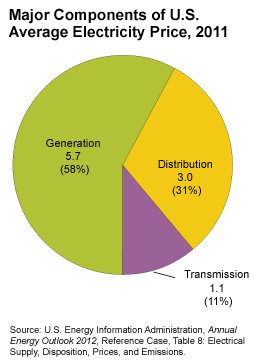The cost of generating electricity is the largest component of the price of electricity.

Did You Know?
The cost to generate electricity actually varies minute-by-minute.
Throughout a single day, the wholesale price of electricity on the electric power grid1 reflects the real-time demand for electricity. Demand is usually highest in the afternoon and early evening when usage is at a peak (so called "on-peak" hours) which means prices are higher at these times.
However, most consumers pay rates based on the seasonal average price of electricity so they do not experience these price fluctuations.
Many Factors Impact Electricity Prices
Electricity prices generally reflect the costs to build, finance, maintain, manage, and operate power plants and the electricity grid (the complex system of power transmission and distribution lines), and to operate and administer the utilities that supply electricity to consumers. Some utilities are for-profit, and their prices include a return for the owners and shareholders.
Some key factors that affect the price of electricity include:
- Fuels — Coal is relatively inexpensive while natural gas tends to be more costly.
- Power plants — Construction and maintenance costs are greater for some kinds of power plants than others.
- Transmission and distribution lines — Maintaining and using the transmission system to deliver electricity contributes to the cost of electricity.
- Weather conditions — Rain and snow can provide water for hydropower generation. Extreme heat can increase the demand for electricity for cooling.
- Regulations — In some states, prices are fully regulated by Public Service Commissions, while in others there is a combination of unregulated prices (for generators) and regulated prices (for transmission and distribution).
Electricity Prices Are Usually Highest in the Summer
The cost to generate electricity actually changes minute-by-minute. However, most consumers pay rates based on the seasonal cost of electricity. Changes in prices generally reflect variations in electricity demand, availability of different generation sources, fuel costs, and plant availability. Prices are usually highest in the summer because more expensive generation is added to meet the higher demand.
Learn more about the interconnection between electricity prices and demand in this detailed article.
Electricity Prices Vary by Type of Customer
Prices are usually highest for residential and commercial consumers because it costs more to distribute electricity to them. Industrial consumers also use more and can take their electricity at higher voltages so it does not need to be stepped down. These factors make the price of power to industrial customers closer to the wholesale price of electricity.
In 2011, the average retail price of electricity in the United States was 10.0 cents per kilowatt-hour (kWh). The average prices by type of utility customer were:
- Residential: 11.8¢ per kWh
- Transportation: 10.6¢ per kWh
- Commercial: 10.3¢ per kWh
- Industrial: 6.9¢ per kWh
Electricity Prices Vary by Locality
Prices vary by locality due to the availability of power plants and fuels, local fuel costs, and pricing regulation and structures. In 2010, annual average electricity prices ranged from 25.1 cents per kWh in Hawaii to 6.2 cents per kWh in Wyoming. State Electricity Profiles include annual prices other statistics for each state.



